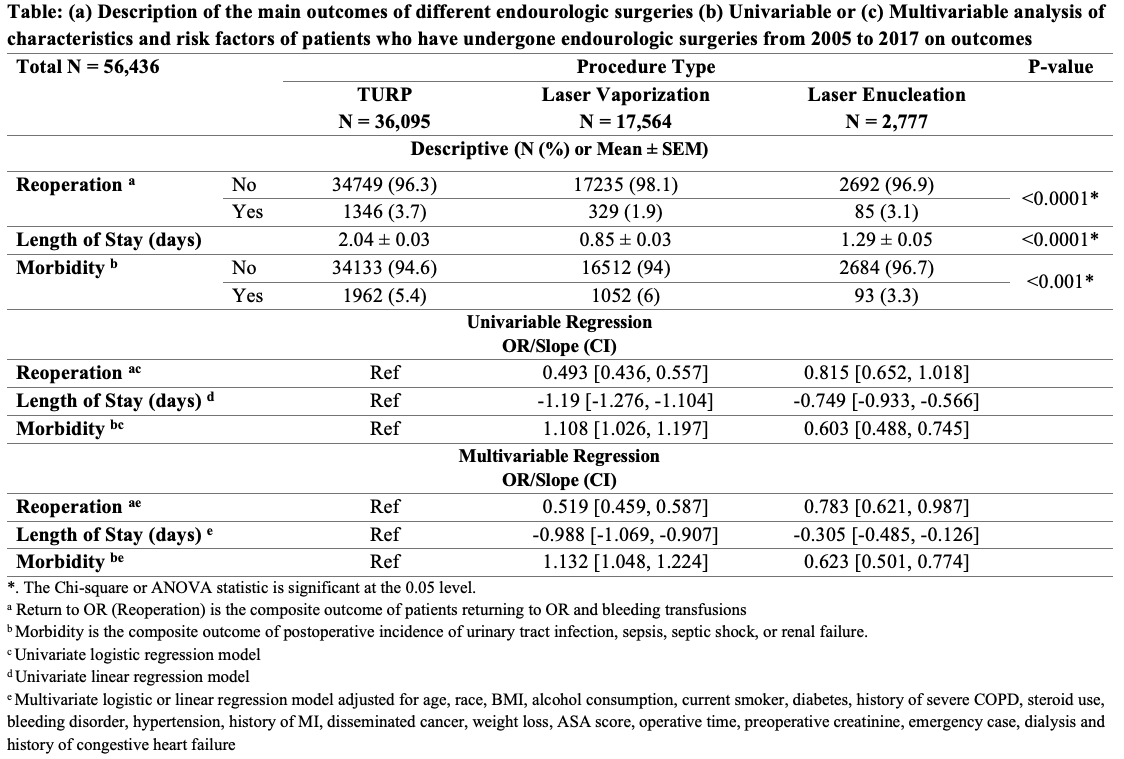Back
Poster, Podium & Video Sessions
Moderated Poster
MP29: Benign Prostatic Hyperplasia: Surgical Therapy & New Technology III
MP29-01: Comparison of postoperative outcomes of transurethral resection of the prostate, laser vaporization or laser enucleation for benign prostatic hyperplasia treatment using the American College of Surgeons National Surgical Quality Improvement Program (ACS-NSQIP) dataset
Saturday, May 14, 2022
1:00 PM – 2:15 PM
Location: Room 225
Christian Ayoub*, Rachelle Haber, Reem Amine, Diana Mikati, Albert El Hajj, Beirut, Lebanon

Christian Habib Ayoub, MD, BS
American University of Beirut Medical Center
Poster Presenter(s)
Introduction: Novel laser techniques for treating benign prostatic hyperplasia (BPH) are challenging gold standard techniques such as transurethral resection of the prostate (TURP). Comparing the outcomes of different techniques might serve in determining safety and efficacy compared to the current gold standard. The aim of this study is to compare the postoperative outcomes of three types of endourologic surgeries (TURP, laser vaporization (PVP) and laser enucleation (LEP)) for BPH treatment using the ACS-NSQIP database.
Methods: The ACS-NSQIP database was queried for men >50 years of age who underwent TURP, PVP and LEP for treatment of BPH from 2005 till 2017. Demographics, clinical, operative characteristics, and 30-day outcomes were compared. Univariate and multivariate regression models were performed for return to the operating room, morbidity, and length of hospital stay.
Results: 56,436 patients underwent endourologic surgeries for BPH, 64.0% had TURP, 31.1% PVP, and 4.9% LEP. Patients undergoing TURP were more likely to be smokers (11.2%, p-value <0.001), have diabetes (21.8%, p-value <0.001), with history of COPD (6.8%, p-value <0.001), disseminated cancer (1.5%, p-value <0.001), weight loss (0.6%, p-value 0.039), congestive heart failure (1%, p-value 0.02), and presenting as emergency cases (2.3%, p-value <0.001). Lower rates were seen in laser vaporization followed by laser enucleation with morcellation. After adjusting for covariates, PVP and LEP showed less return to the operating room with a 48.1% and 21.7% decrease in the odds as compared to TURP, respectively. PVP showed a significant 13.2% increase in the odds of experiencing morbidity as opposed to a decrease of 37.5% in LEP as compared to TURP. PVP and LEP showed a decrease in hospital stay by 0.988 and 0.305 days as compared to TURP, respectively.
Conclusions: This study shows superiority of laser techniques in 30-day postoperative outcomes as compared to TURP. Further research is needed to account for longer duration of follow-up and patient-specific urologic outcomes, such as prostate size, urinary incontinence, erectile dysfunction, and retrograde ejaculation.
Source of Funding: None

Methods: The ACS-NSQIP database was queried for men >50 years of age who underwent TURP, PVP and LEP for treatment of BPH from 2005 till 2017. Demographics, clinical, operative characteristics, and 30-day outcomes were compared. Univariate and multivariate regression models were performed for return to the operating room, morbidity, and length of hospital stay.
Results: 56,436 patients underwent endourologic surgeries for BPH, 64.0% had TURP, 31.1% PVP, and 4.9% LEP. Patients undergoing TURP were more likely to be smokers (11.2%, p-value <0.001), have diabetes (21.8%, p-value <0.001), with history of COPD (6.8%, p-value <0.001), disseminated cancer (1.5%, p-value <0.001), weight loss (0.6%, p-value 0.039), congestive heart failure (1%, p-value 0.02), and presenting as emergency cases (2.3%, p-value <0.001). Lower rates were seen in laser vaporization followed by laser enucleation with morcellation. After adjusting for covariates, PVP and LEP showed less return to the operating room with a 48.1% and 21.7% decrease in the odds as compared to TURP, respectively. PVP showed a significant 13.2% increase in the odds of experiencing morbidity as opposed to a decrease of 37.5% in LEP as compared to TURP. PVP and LEP showed a decrease in hospital stay by 0.988 and 0.305 days as compared to TURP, respectively.
Conclusions: This study shows superiority of laser techniques in 30-day postoperative outcomes as compared to TURP. Further research is needed to account for longer duration of follow-up and patient-specific urologic outcomes, such as prostate size, urinary incontinence, erectile dysfunction, and retrograde ejaculation.
Source of Funding: None


.jpg)
.jpg)